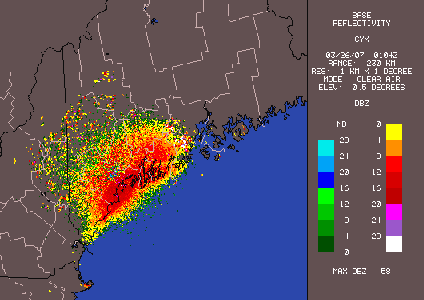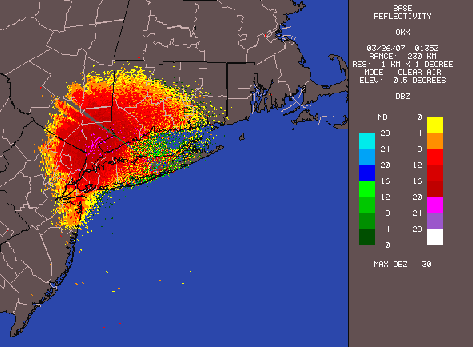 |
NEXRAD radar image from near Portland, Maine--early evening of March 25, 2006
The ice went out this weekend in the river outside my office here in Maine and this early April morning I am relishing a Boreal waterfowl show. There are three male Common Goldeneye swarming around two females. The males toss their black heads back against their white backs as each tries to convince the ladies that he is the best. Looking more restrained are ten Ring-necked Ducks swimming along the opposite shore—they always seem to portray a sense of comic elegance. It must come from the combination of the velvety black and gray plumage coupled with the funny peaked head and clown-like white-striped bill. And then there are scads of Common Mergansers—large, rather heavy bodied and the males (mostly that's what I have here in the river today) with their sharp white bodies, black heads, and thin bright reddish bills made perfectly for snagging the smelt that are just now moving into spawning mode.
Speaking of migrants, I had a little mystery recently.
Last week just after the northeast U.S. was hit with a wave of Fox Sparrows heading back north from their southeastern U.S. wintering area, I was getting antsy to see if I could start picking up some nocturnal migrants on my microphone set-up. Sure it was a bit early but I knew that Fox Sparrows seemed to be across most of the northern U.S. states as well as lots of Song Sparrows and Dark-eyed Juncos. Eastern Phoebes and Yellow-bellied Sapsuckers had been appearing in more and more places as well plus waterfowl and American Woodcock and various other of the earlier wave of migrants.
So I took a peek at the NEXRAD radars from a few places to my south--Portland, Boston, Long Island, Philadelphia. Let me make it clear right from the start that I am no expert in interpreting radar. What I know comes from reading what the radar ornithology experts have provided in various explanations for how to interpret the radar images which are readily available in real time over the Internet.
But what I saw looked like what I thought should be migrating birds. All along the northeastern seaboard including in Maine, there was no precipitation and very light or no wind. The radars were operating in "clear air" mode and there were clouds of something in the atmosphere reflecting back from the radar pulses. With the NEXRAD radar you can also look at the direction and speed of whatever the radar beams are detecting in the air. When I checked this out I found that whatever was in the atmosphere was moving at least twice as fast as the wind speeds in the area. According to what I've read, if it is fog or dust or insects that are what is being detected by the radar then you expect them to be moving at about the same speed as the wind not faster—especially not a lot faster.
 |
NEXRAD radar image from near New York City--early evening of March 25, 2006
So I was pretty excited to get my microphone set up on the deck and plugged into the computer with the automatic call detection software running. After all, it looked like I should pick up a bunch of calls of migrating birds. I plugged it all in, got the computer running, and went to bed.
The next morning I rushed downstairs, put the tea kettle on, and sat down at my computer to see what had flown over.
But what a disappointment. Instead of the high sweet "seeps" of sparrows there was only page after page of sonograms with drips and creaks, the neighbor's wind chimes, and an occasional low "whoosh" of a passing car.
What was going on? The radar had showed what seemed to be birds moving but where was the audio evidence?
The answer, I think, may have been made clearer by the handful of bird sounds that my nocturnal listening station did pick up.
At about 9:15, my station picked up the sounds of a flock of migrating Canada Geese. An hour later there was the distinctive whistle of the wings of an American Woodcock. And several other times during the night the microphone picked up what sounded like more distant beating wings.
Many people, even birders, are surprised at some of the species that are night migrants. For example, few people realize that most North American waterfowl species migrate at night. One May evening this was brought home to me in a major way when, during the waning hours of the World Series of Birding, we watched flocks of hundreds of Green-winged Teal lifting off from a salt marsh in southern New Jersey as they headed north.
Shorebirds are also major night migrants and, of course, most songbirds but not just sparrows and warblers but also birds like Winter Wrens, Ruby-crowned Kinglets, and Yellow-bellied Sapsuckers.
One thing that many of these earlier migrants have in common is that they are either less vocal or make no sounds during nocturnal migration. Many of the waterfowl will occasionally call but you may be more likely to just occasionally pick up the sounds of their wings. Wrens, kinglets, flycatchers, and woodpeckers usually don't even let out a peep.
So I wonder if the answer to my question of "where were the birds?" was that there may have been birds passing over but they weren't making many sounds for my listening station to pick up. Though I still wonder why I didn't pick up any sparrows or juncos…….
You probably know by now that most of the birds I mentioned above have significant portions of their breeding range in the Boreal and are headed there now in the hopes of finding the places they left last year unchanged and perfect for raising their young.
Want to help keep those goldeneyes dancing and Fox Sparrows singing in your backyards and parks? Click here to help.
Think you're already a Boreal bird expert? Try this quiz or watch this movie.

